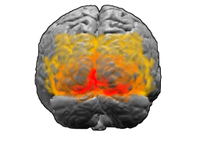
Photo from wikipedia
To understand visual motion processing underlying the optokinetic response (OKR), we developed a biomimetic model that reproduces the findings from behavioral experiments. We recorded OKRs induced by drifting gratings with… Click to show full abstract
To understand visual motion processing underlying the optokinetic response (OKR), we developed a biomimetic model that reproduces the findings from behavioral experiments. We recorded OKRs induced by drifting gratings with different spatiotemporal frequencies from humans and non-human primates. The characteristics of the initial open-loop responses and the closed-loop eye velocity gains were analyzed using a model developed in this study. The model consists of two pathways with different dynamics. One mediates the transient response (transient pathway) and the other the sustained response (sustained pathway). Each pathway has a different spatiotemporal frequency dependence. Assuming there are different visual sensitivities for these pathways, one tuned to lower spatial and higher temporal frequencies on the retina and the other tuned to stimulus velocity, we successfully reproduced the course of OKRs. Our results suggest that two different neural circuitries/populations contribute to visual processing in the different stages of OKRs.
Journal Title: Progress in brain research
Year Published: 2019
Link to full text (if available)
Share on Social Media: Sign Up to like & get
recommendations!